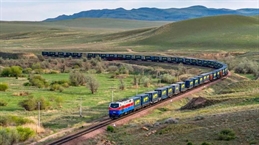
One illustration of growing interest in the Middle Corridor is the amount of money already committed to projects along its route, attendees of the Black and Caspian Sea Ports and Logistics 2024 conference in Constanta, Romania, heard on July 3.
Already causing a sharp debate about whether it should be built for use or the need for it proven first, the corridor is the route which will see cargo move east to west across both the Caspian and Black seas. Very much a multimodal project, it is also multi-country, multi-gauge and is sometimes referred to as the Trans-Caspian International Transport Route or (TITR).
At the European end, Constanta has pledged to an expansion plan priced at €1.1 billion (US$1.2. billion) said Frank Busse, vice president, Europe, and a partner at HPC Hamburg Port Consulting, who gave an overview of likely developments along the corridor.
This funding pledge is for development of Pier IIIS-IVS in the city’s South Port, information obtained from port authorities said. There are other projects under preparation, none cheap and some sizable, such as €122.6 million to improve road infrastructure and €162 million for the construction of quays in the Port of Constanta, it added.
Across the Black Sea, Anaklia, Georgia, is to see a huge port built, reportedly now assigned to a Chinese consortium, while just down the same coast, Poti, another possible Georgian megaport, is to get an expansion of valued at US$200 million. “Let’s see,” was Busse’s view on these developments.
Again on the Caspian, Azerbaijan and Kazakhstan are said to be spending up to US$300 million on ports, with the Azerbaijan Caspian Shipping Company spending a further US$60 million on ships.
Small – for the time being, at least – Kazakhstani ports Aktau and Kurik are also going to invest big time, with a reported US$600 million being invested there. Further down the eastern side of the Caspian Sea, Turkmenbashi Port in Turkmenistan is said to be investing up to US$1.5 billion. “Sounds a lot” was Busse’s take, adding that it was “probably a long-term investment plan.”
The numbers beyond that are more astounding still. Earlier in the year, the European Union announced an overall commitment to invest €10 billion in sustainable transport connectivity in Central Asia, a figure still causing much head shaking in Constanta some six months later.
Agreements reached also included an EU-funded regional transport programme to be adopted in 2025, where the EU will offer technical assistance to advance existing and future transport-related projects, a coordination platform to monitor progress and development and a regional prosperity-focused programme geared towards practical operations and usage of the trans-Caspian transport networks.
From this year, there will be resident twinning advisors, officials embedded in the Ministries of Transport of all five Central Asian countries, and in the coming months, meetings on soft connectivity will start.
“A lot of money, a lot of investment is in the market, there is something going on as everyone is thinking about how to participate in this cargo flow,” Busse told the Constanta conference.
The EU is not the only entity moving with speed. Across the corridor and beyond it, those on the ground and in the private sector are calling help in in the form of consultants, he added.
Working down that line, HPC is “currently working” on a feasibility study for a port community system in Romania, Busse said.
During the past three years, Georgia has generated “quite a wide range of projects” for HPC, including development of a maritime single window pilot scheme, feasibility studies for a logistics centre in Tbilisi and a special economic zone at Poti, where there is also a market analysis being done for the region, he added.
In Kazakhstan, a private terminal rail operator asked for and is mulling intermodal terminal operations. At the other end of the corridor is Hungary, one of the landlocked southeastern European countries it is designed to serve.
There, there is a project on intermodal terminal optimizations and intermodal TOS implementation support.
“These are quite some requests,” said Busse, who described the process to Asia Cargo News as “dynamic,” having really taken off with the Ukraine war and with three calls a week ongoing.
Freight is already moving along the corridor, which carried 2.75 million tons last year, up 86% on the 2022 total. Its potential is huge, with two drivers end-to-end, the countries beyond it and a possibility of 500,000 TEUs in what Busse termed “inner trade,” between countries along it.
“This additional infrastructure is supporting the development of the region,” Busse said. But the question of who pays for its full potential to be reached is there and big. “I believe we have to build something first. This is the challenge: heavy asset investment.”
By Michael Mackey
Correspondent | Constanta, Romania



